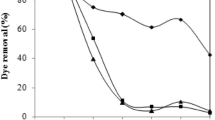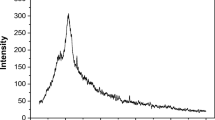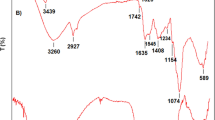Abstract
Biosorption has potential to be an economical colour removal technology. As such, the colour removal potential of inactivated Aspergillus niger biomass was investigated for the treatment of activated sludge-treated pulp mill effluent from a northern bleached softwood kraft mill. Biomass pretreatment methods, effects of initial pH of the effluent and preparative biomass washing methods were examined. The most effective pretreatment method was found to be simple autoclaving of the biomass and this approach was applied in subsequent kinetic and isotherm batch studies. It was also found that the pH of the wastewater prior to addition of the biomass affected the biosorption rate and the solubility of chromophores in pulp mill effluent. The results also indicated that biomass washing methods reduced the quantity of organic matter leached from the fungal biomass during application. The kinetic study revealed that colour removal by biosorption occurred most readily in the first 8 h and could be described adequately by both the Lagergren and Ho et al. models. The maximum colour removal was over 900 TCU, with a biomass dose of about 20 g/L. The isotherm study data were fitted with the BET isotherm model. The results indicated that adsorption occurred in a multi-layer fashion and that physical adsorption was the main mechanism contributing to the biosorption. Therefore, dead A. niger biomass was concluded to be a promising alternative for colour removal from pulp mill effluent.









Similar content being viewed by others
References
American Public Health Association, American Water Works Association & Water Pollution Control Federation. (1998). Standard methods for examination of water and wastewater (20th ed.). Washington: American Public Health Association.
Bajpai, P. (2001). Microbial degradation of pollutants in pulp mill effluents. Advances in Applied Microbiology, 48, 79–134.
Banat, I. M., Nigam, P., Singh, D., & Marchant, R. (1996). Microbial decolorization of textile-dye-containing effluents: A review. Bioresource Technology, 58(3), 217–227.
Banks, C. J., & Parkinson, M. E. (1992). The mechanism and application of fungal biosorption to color removal from raw waters. Journal of Chemical Technology and Biotechnology, 54(2), 192–196.
Do, D. D. (1998). Adsorption analysis: Equilibria and kinetics. London: Imperial College Press.
Fu, Y. Z., & Viraraghavan, T. (2000). Removal of a dye from an aqueous solution by the fungus Aspergillus niger. Water Quality Research Journal of Canada, 35(1), 95–111.
Fu, Y. Z., & Viraraghavan, T. (2001a). Fungal decolorization of dye wastewaters: A review. Bioresource technology, 79(3), 251–262.
Fu, Y. Z., & Viraraghavan, T. (2001b). Removal of CI Acid Blue 29 from an aqueous solution by Aspergillus niger. AATCC Review, 1(1), 36–40.
Fu, Y. Z., & Viraraghavan, T. (2002). Dye biosorption sites in Aspergillus niger. Bioresource Technology, 82(2), 139–145.
Gallagher, K. A., Healy, M. G., & Allen, S. J. (1997). Biosorption of synthetic dye and metal ions from aqueous effluents using fungal biomass. In D.L. Wise (Ed.), Third International Symposium of the International Society for Environmental Biotechnology (pp. 27). Elsevier Science.
Ho, Y. S. (2004). Citation review of Lagergren kinetic rate equation on adsorption reactions. Scientometrics, 59(1), 171–177.
Ho, Y. S., Wase, D. A. J., & Forster, C. F. (1996). Kinetic studies of competitive heavy metal adsorption by sphagnum moss peat. Environmental Technology, 17(1), 71–77.
Jacksonmoss, C. A., Maree, J. P., & Wotton, S. C. (1992). Treatment of bleach plant effluent with the biological granular activated carbon process. Water Science and Technology, 26(1–2), 427–434.
Kapoor, A., Viraraghavan, T., & Cullimore, D. R. (1999). Removal of heavy metals using the fungus Aspergillus niger. Bioresource Technology, 70(1), 95–104.
Kemeny, T. E., & Banerjee, S. (1997). Relationships among effluent constituents in bleached kraft pulp mills. Water Research, 31(7), 1589–1594.
Lagergren, S. (1898). About the theory of so-called adsorption of soluble substances. Kungliga Swenska Vetenskapsakademiens. Handlingar, 24(4), 1–39.
Mou, D. G., Lim, K. K., & Shen, H. P. (1991). Microbial agents for decolorization of dye waste-water. Biotechnology Advances, 9(4), 613–622.
Rao, J. R. (2001). Biosorption of phenol by Aspergillus niger biomass. Master Thesis, Saskatchewan: The University of Regina.
Sawyer, C., McCarty, P., & Parkin, G. (2003). Chemistry for environmental engineering and science (5th ed.). New York: McGraw-Hill.
Sevimli, M. F., & Kinaci, C. (2002). Decolorization of textile wastewater by ozonation and fenton’s process. Water Science Technology, 45, 279–286.
Springer, A. (1986). Environmental industrial control: Pulp and paper industry. New York: Wiley.
Zhou, J. L., & Banks, C. J. (1991). Removal of humic acid fractions by Rhizopus arrhizus: Uptake and kinetic-studies. Environmental Technology, 12(10), 859–869.
Zhou, J. L., & Banks, C. J. (1993). Mechanism of humic-acid color removal from natural-waters by fungal biomass biosorption. Chemosphere, 27(4), 607–620.
Acknowledgements
Throughout the laboratory work, the assistance and guidance of Susan Harper and Paula Parkinson has been vital and is greatly appreciated. This research was funded by the Natural Sciences and Engineering Research Council (NSERC) of Canada.
Author information
Authors and Affiliations
Corresponding author
Rights and permissions
About this article
Cite this article
Grainger, S., Fu, G.Y. & Hall, E.R. Biosorption of Colour-Imparting Substances in Biologically Treated Pulp Mill Effluent Using Aspergillus niger Fungal Biomass. Water Air Soil Pollut 217, 233–244 (2011). https://doi.org/10.1007/s11270-010-0582-y
Received:
Accepted:
Published:
Issue Date:
DOI: https://doi.org/10.1007/s11270-010-0582-y




